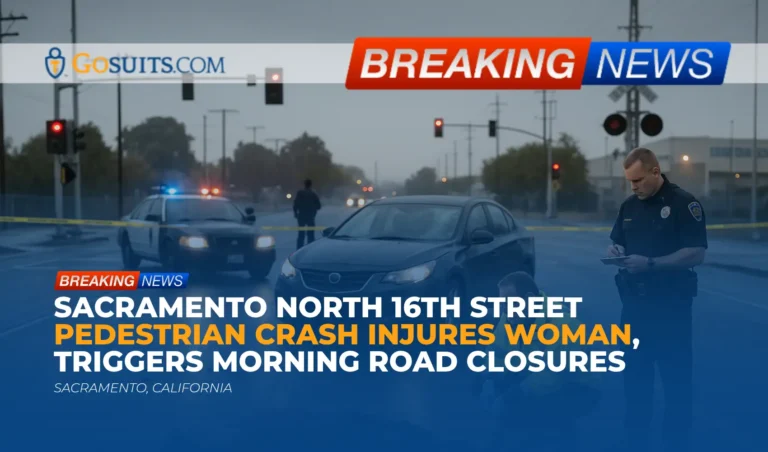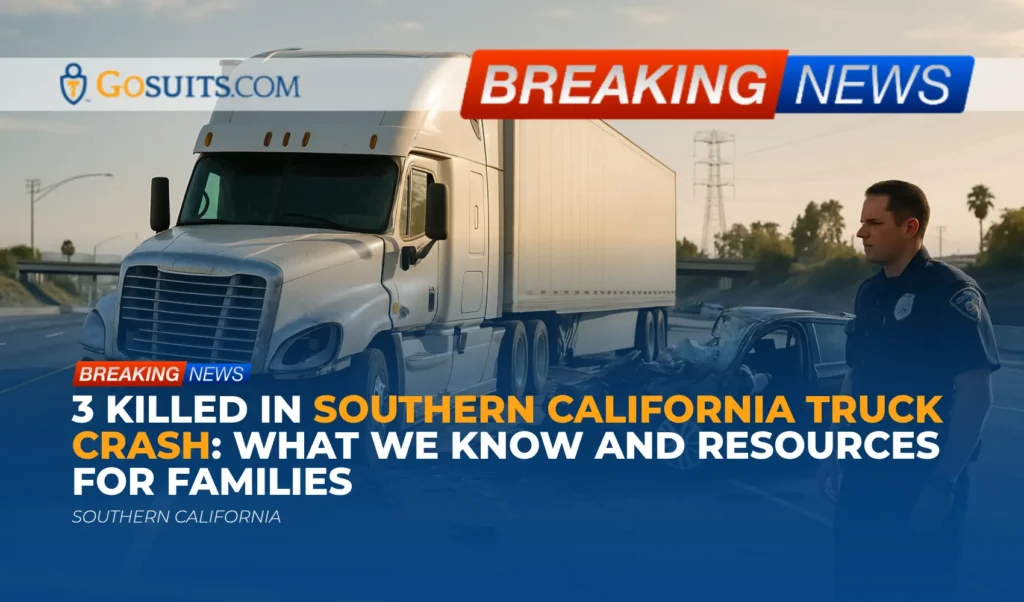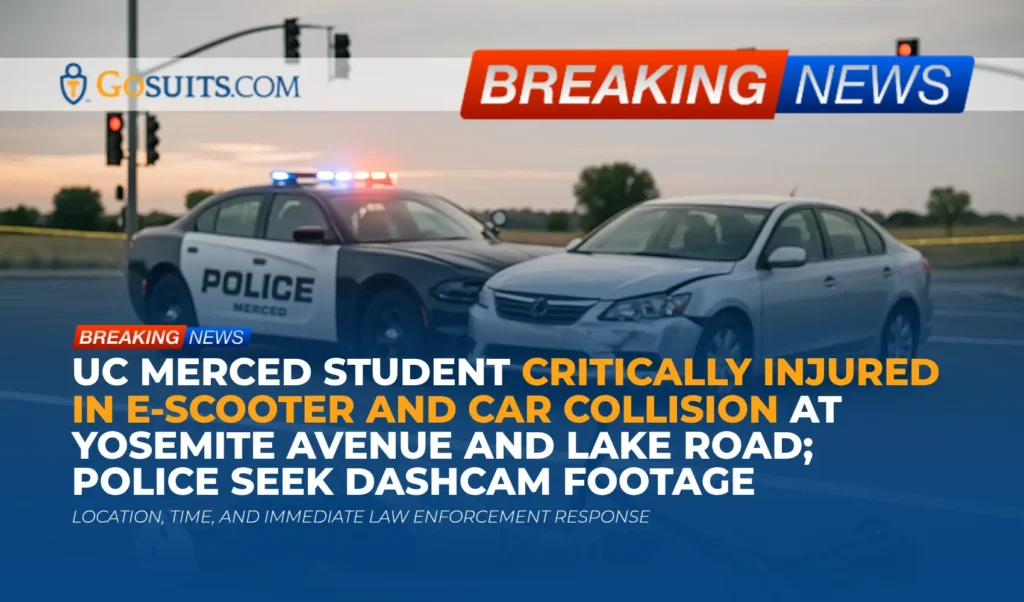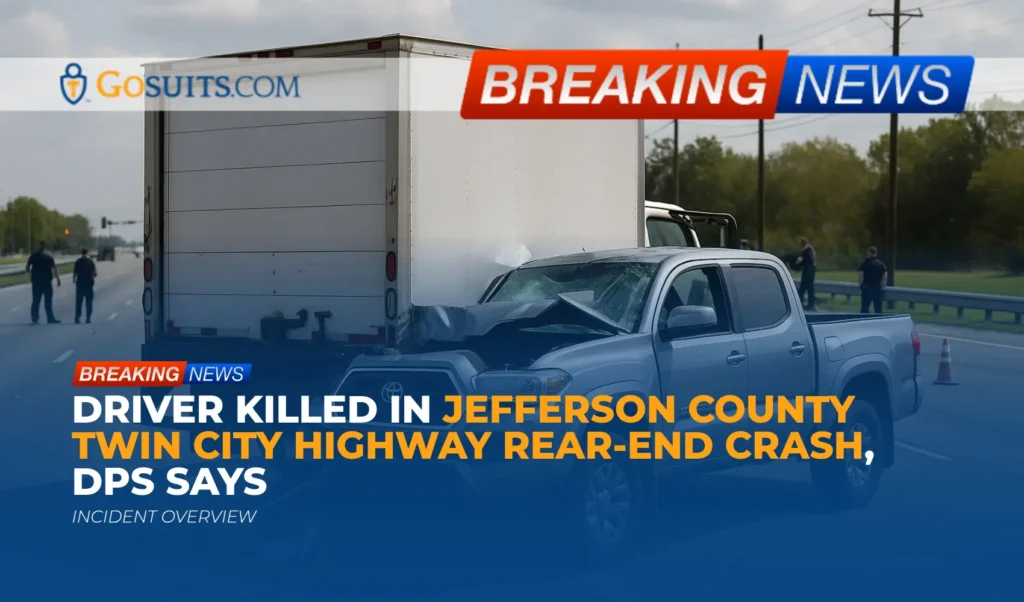- What We Know About the North 16th Street Pedestrian Crash in Sacramento
- Location Context and Traffic Disruptions Reported This Morning
- Immediate Steps Caring Friends or Community Members Can Take
- How California Law Looks at Pedestrian Collisions
- Possible Civil Liability and Insurance Considerations
- Evidence to Preserve After a Pedestrian Crash
- Where to Obtain Official Records and Assistance
- Safety and Roadway Factors Investigators Commonly Review
- Data and Trends: Pedestrian Injuries and Fatalities
- Key Deadlines in California Injury and Wrongful Death Claims
- Commentary from Gosuits Sacramento, California Personal Injury Attorney
- Action Steps and Urgency: Why Timing Matters
What We Know About the North 16th Street Pedestrian Crash in Sacramento
Early Monday morning, a pedestrian was struck by a vehicle in Sacramento near the corridor of North 16th Street between North B and North C Streets. Emergency medical services were dispatched at approximately 5:35 a.m. A woman with injuries was transported to a nearby hospital for treatment. At the time of the initial reports, the precise cause of the collision had not been determined, and police were actively investigating the scene.
Law enforcement activity led to traffic closures on North 16th Street at North C Street, as well as closures on North B Street and Ahern Street. The closure was near the railroad grade crossing and the Blue Diamond facility area, a spot familiar to many morning commuters traveling from downtown toward State Route 160. The northbound direction along 16th was blocked while investigators worked, with no definite timeline for reopening offered in the early updates.
Because the cause is not yet known, it is important to avoid speculation. Investigations of pedestrian collisions typically assess driver behavior, pedestrian positioning and movement, roadway conditions, sightlines, lighting, traffic controls, and any relevant vehicle or infrastructure factors.
Location Context and Traffic Disruptions Reported This Morning
The affected area lies along a well-traveled commuter route north of downtown Sacramento where 16th Street rises over a rail line before connecting toward SR-160. Morning drivers heading out of downtown encountered closures at C Street, with detours around the scene. This is a corridor with mixed traffic, industrial access points, nearby rail infrastructure, and changing line-of-sight as the roadway crests over the tracks. These features can affect visibility and vehicle speeds, especially before dawn.
Collisions in low-light hours often require extended on-scene work to gather measurements and preserve evidence. When a pedestrian is involved, agencies typically document vehicle positions, roadway markings, crosswalks, traffic control timing, lighting conditions, and any camera footage available from nearby facilities or traffic systems.
Immediate Steps Caring Friends or Community Members Can Take
When a serious pedestrian crash occurs, concerned neighbors or community members often seek ways to be supportive. These general steps can help ensure safety, maintain information, and support the person injured and their family:
- Ensure current safety first. Keep a safe distance from active emergency scenes and follow directions from law enforcement. Do not enter closed areas.
- Avoid sharing unverified details online. Early information can change. Sharing speculation can harm those involved and complicate investigations.
- Preserve information if you witnessed the event. If you saw what happened, write down the time, location, and what you observed. Witness memories fade quickly. When safe and appropriate, provide your contact information to the investigating officer.
- Collect non-intrusive scene details, if safe. If you arrived after the incident and it is safe and permitted, note environmental conditions such as lighting, weather, nearby construction, or unusual traffic patterns that might be relevant.
- Support the injured person’s family with practical help. Offer transportation, childcare, meal support, or help tracking appointments. Recovery from pedestrian injuries can be long and exhausting.
- Encourage careful communications with insurers. Insurance representatives may reach out quickly. Statements can be used later. It is wise to speak with a seasoned attorney for a free consultation before any recorded statement.
How California Law Looks at Pedestrian Collisions
California’s traffic laws set duties for both drivers and pedestrians. Some key statutes commonly involved in these collisions include:
- Right of way in crosswalks. Drivers must yield the right-of-way to pedestrians crossing the roadway within any marked crosswalk or within any unmarked crosswalk at an intersection. See California Vehicle Code section 21950 at the state’s official code site: leginfo.legislature.ca.gov.
- Pedestrians outside crosswalks. Pedestrians crossing outside of crosswalks must yield the right-of-way to vehicles that are close enough to present a hazard. See California Vehicle Code section 21954: leginfo.legislature.ca.gov.
- Driver duties and due care. Even when a pedestrian is not in a crosswalk, drivers must exercise due care for the safety of any pedestrian upon a roadway. Careful driving and appropriate speed for conditions are always required.
California follows comparative fault principles, which means liability for damages can be shared among those whose actions contributed to the incident. The state’s courts system provides public information on civil cases and fault concepts here: courts.ca.gov. In practical terms, investigators, insurers, and courts look at each party’s conduct: where the pedestrian was walking, whether signals were obeyed, whether the driver was attentive and driving at a safe speed for conditions, and whether any roadway or visibility issues played a role.
Possible Civil Liability and Insurance Considerations
In a pedestrian-vehicle collision, several insurance coverages may be relevant depending on the circumstances:
- Driver’s liability coverage. If a driver’s negligence contributed to the crash, their auto liability policy is typically a primary source for injury claims.
- Uninsured/underinsured motorist (UM/UIM). If the driver lacked sufficient insurance, the injured person’s own auto insurance policy may include UM/UIM benefits that can apply, even when they were walking. Policy terms vary.
- Medical payments coverage (Med-Pay). Some auto policies include no-fault Med-Pay that can help with immediate medical bills regardless of fault, up to the policy limits.
- Potential public entity issues. If a dangerous roadway condition, signal timing malfunction, or design issue contributed, there can be special notice requirements for claims against a public entity. See California Government Claims Act deadlines below.
Insurance companies may contact involved individuals quickly and ask for recorded statements or releases. Those statements can be used later to limit recovery. Speaking with a skilled attorney for a free consultation before engaging with insurers can help someone understand their rights and protect their claim. For collisions that result in injury or death, California law also requires drivers to report the crash to law enforcement without unnecessary delay. See Vehicle Code section 20008 at leginfo.legislature.ca.gov.
Additionally, California requires that a crash involving injury or property damage of $1,000 or more be reported to the DMV within 10 days using Form SR-1. See the California Department of Motor Vehicles page: dmv.ca.gov.
Evidence to Preserve After a Pedestrian Crash
Clear, early documentation can be crucial in understanding what happened. Consider the following types of information and evidence that are frequently important:
- Photographs and video. Photos of the scene, vehicle positions, skid marks, debris, roadway signage, crosswalks, and lighting can be helpful. Nearby businesses or facilities may have exterior cameras. Caltrans and local agencies may have traffic cameras near state routes; see Caltrans QuickMap for camera locations at quickmap.dot.ca.gov although retention is typically short.
- Witness information. Names, phone numbers, and brief statements from people who saw the events before, during, or after the collision are valuable.
- Vehicle data. Many modern vehicles contain event data recorders. Preserving the vehicle and its onboard data can be important when speed or braking is disputed.
- Emergency response records. Dispatch logs, EMS run sheets, and hospital intake notes can establish timing, reported symptoms, and initial observations.
- Medical records. Keep copies of all medical visits, imaging, prescriptions, and referrals. Consistent documentation helps track the course of injuries and recovery.
- Roadway information. Signal timing charts, maintenance logs, and any recent construction records may be held by local agencies or Caltrans District 3 for state-managed facilities: dot.ca.gov.
If an insurer or opposing party is involved, formal preservation letters can request that specific evidence be retained. Because wording matters, consulting an attorney before contacting insurers is recommended so that nothing said is later used out of context.
Where to Obtain Official Records and Assistance
Police Traffic Collision Report
The investigating law enforcement agency compiles the official traffic collision report. For a crash on North 16th Street within Sacramento city limits, that is typically the Sacramento Police Department. The report contains officer narratives, diagrams, and sometimes preliminary fault assessments. Individuals with a direct interest, such as the involved pedestrian or family, may request a copy once it is approved and released. The report number is often provided at the scene or can be obtained by referencing the date, time, and location.
California law outlines reporting obligations for injury collisions at Vehicle Code section 20008: leginfo.legislature.ca.gov. While each agency has its own records process and forms, the general steps include identifying the involved parties, providing proof of interest, and paying any applicable fee. If the California Highway Patrol investigated instead of city police, CHP provides reports through its local office system. CHP has multiple area offices; the Sacramento region is within CHP’s jurisdiction for state highways and certain corridors.
Emergency Medical Services and Hospital Records
EMS run reports and hospital records can be requested by the patient or authorized representative. These documents detail treatment, observations, and transport times. Hospitals require proper authorization for release. EMS agencies maintain their own request procedures and may require a HIPAA-compliant authorization form.

Autopsy and Coroner’s Office Records
In the most serious cases where a person does not survive, the county coroner handles investigations and death certification. In Sacramento County, coroner services are administered by the county. The county’s official website provides information about the coroner’s functions and contact details: saccounty.gov. Depending on the case, next of kin can request autopsy findings, cause and manner of death, and available reports once finalized. Death certificates in California are issued through the California Department of Public Health’s Vital Records division: cdph.ca.gov.
Traffic Engineering and Signal Timing Information
When a collision occurs near a state highway or ramp, Caltrans District 3 may maintain certain traffic engineering records for state-controlled facilities. Public information on District 3 can be found at dot.ca.gov. If the facility is city-controlled, the city’s public works or transportation department may hold timing sheets or maintenance logs. Agencies often require a Public Records Act request for these records. The level of detail available varies by jurisdiction and system.
Safety and Roadway Factors Investigators Commonly Review
Because the reported crash happened around 5:35 a.m., darkness and artificial lighting conditions likely prevailed. Investigators typically assess:
- Lighting and sight distance. Whether streetlighting was operational, any shadows or glare, vertical curves over rail lines, and obstacles that could impair a driver’s view.
- Traffic control devices. Presence and operation of signals, pedestrian push buttons, crosswalk markings, and signage.
- Vehicle speed relative to conditions. Driving at a prudent speed in low-light is essential. The Federal Highway Administration emphasizes managing speeds to reduce injury severity: highways.dot.gov.
- Roadway surface and environment. Pavement condition, debris, lane closures, construction, or wet surfaces can affect vehicle control and stopping distance.
- Human factors. Driver attention, impairment screening, pedestrian conspicuity, and crossing patterns are all within the typical scope of a full investigation.
Findings from these elements inform both safety improvements and any civil responsibility analysis.
Data and Trends: Pedestrian Injuries and Fatalities
Understanding broader data can give context to individual incidents:
- National trends. The National Highway Traffic Safety Administration reports thousands of pedestrian fatalities annually in the United States, and a higher risk during low-light hours. See NHTSA’s pedestrian safety overview: nhtsa.gov.
- Public health perspective. The Centers for Disease Control and Prevention provides data on nonfatal injuries and prevention strategies for pedestrians: cdc.gov.
- Speed and survivability. Federal safety research highlights that impact speeds strongly influence injury severity, supporting measures that encourage appropriate speeds in urban corridors. See FHWA resources on speed management: highways.dot.gov.
These resources reflect general patterns: night-time and dawn/dusk hours, complex urban intersections, and corridors with changing sightlines can present elevated risks. Each collision remains fact-specific, and conclusions should be based on the particular evidence from the scene.
Key Deadlines in California Injury and Wrongful Death Claims
Civil claims are governed by strict timelines. Missing a deadline can forfeit the ability to pursue a claim. Educational points to be aware of include:
- Personal injury statute of limitations. In many California cases, an action for assault, battery, or injury to, or for the death of, an individual caused by the wrongful act or neglect of another must be brought within two years. See California Code of Civil Procedure section 335.1: leginfo.legislature.ca.gov.
- Government entity claims. If any public entity may be responsible, a written claim generally must be presented within six months of the incident. See Government Code section 911.2: leginfo.legislature.ca.gov.
- DMV reporting of crashes. Injuries or property damage of $1,000 or more must be reported to the DMV within 10 days via Form SR-1, regardless of fault: dmv.ca.gov.
There can be exceptions and shorter or longer timeframes depending on the facts, the parties involved, and the type of claim. Because timelines can be complex, it is prudent to obtain a free consultation to understand which deadlines apply.
Commentary from Gosuits Sacramento, California Personal Injury Attorney
Our thoughts are with the woman injured in this morning’s crash and with anyone affected by the closures and uncertainty around North 16th Street. What follows is offered for educational purposes and general information. Each situation is unique, and outcomes depend on specific facts and evidence.
Early-morning pedestrian collisions in urban corridors are often shaped by visibility, roadway geometry around rail crossings, and traffic patterns that change rapidly as commuters leave downtown. Even when the exact cause is not yet known, the law requires all drivers to exercise due care and to yield to pedestrians in crosswalks. Outside of crosswalks, pedestrians have duties too, yet drivers still must drive prudently for conditions. A thorough investigation usually examines lighting, whether signals and markings were clear and functioning, the placement and timing of crosswalks, and whether speed was appropriate for the conditions.
In our experience, insurers and large organizations move quickly after a crash. They may request recorded statements, seek broad medical authorizations, or present early settlement offers before the full scope of injuries and future needs is clear. These tactics can take advantage of a person’s lack of familiarity with claim processes and can affect the ability to obtain fair consideration later. Speaking with a seasoned attorney for a free consultation helps people understand their options, what evidence to preserve, and how to avoid common pitfalls with insurance communications.
Action Steps and Urgency: Why Timing Matters
What should be done now
- Prioritize medical care and follow-up. Attend all appointments, follow medical advice, and keep copies of discharge paperwork and imaging results. Document symptoms and limitations as they evolve.
- Preserve evidence immediately. Save photos, video, clothing, and damaged items. Identify potential cameras at nearby businesses or facilities. Request that any known footage be preserved.
- Identify the investigating agency and report number. Note the agency that responded and obtain the incident or report number to request official records when available.
- Consult an attorney before engaging insurers. A free consultation can clarify rights and next steps. Statements to insurance companies can be used later; understanding what to say and what not to say is important.
- Track all expenses and impacts. Keep receipts and logs for medical bills, medications, travel to appointments, time missed from work, and daily-life impacts related to injuries.
- Calendar legal and administrative deadlines. Note the two-year general limitations period for personal injury claims in California, the six-month claim deadline if a public entity may be involved, and the DMV’s 10-day SR-1 accident report requirement, as applicable.

Why acting promptly matters
- Evidence can disappear quickly. Traffic camera footage and private business recordings are often overwritten within days. Roadway conditions can change. Early preservation efforts can be decisive.
- Memories fade. Witness recollections are freshest immediately after an event. Collecting contact information and statements early can avoid later uncertainty.
- Medical documentation builds the timeline. Gaps in care or missing records can complicate proving the nature and extent of injuries. Prompt and consistent treatment helps create a clear record.
- Insurance communications carry consequences. Recorded statements or broad medical releases given early can limit future options. Understanding the process before speaking with insurers is protective.
- Deadlines are strict. Statutes of limitations and government claim requirements are unforgiving. Calendar deadlines now to avoid last-minute pressure or inadvertent forfeiture of rights.
Where to turn for official information
- California DMV accident reporting. Guidance and SR-1 form: dmv.ca.gov.
- California Vehicle Code (rules for drivers and pedestrians). Crosswalk duties and related provisions: CVC 21950, CVC 21954, and reporting CVC 20008.
- Caltrans District 3. For state-facility traffic engineering or public information in the region: dot.ca.gov.
- Sacramento County resources. County information, including coroner services: saccounty.gov. California Vital Records for death certificates: cdph.ca.gov.
- National safety and public health data. Pedestrian safety overviews from NHTSA: nhtsa.gov, and CDC injury prevention: cdc.gov.






